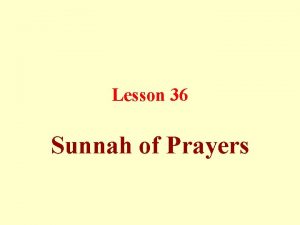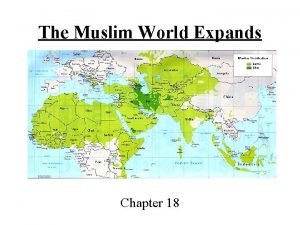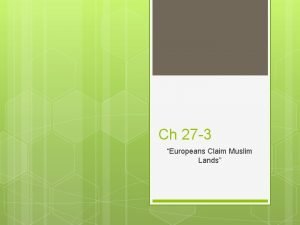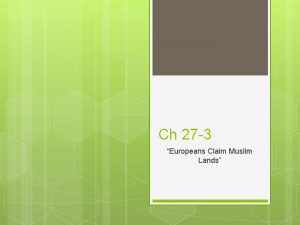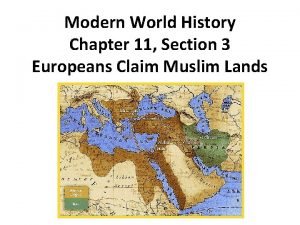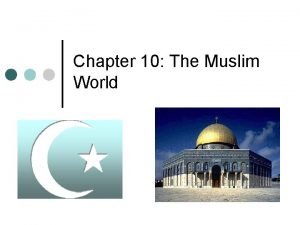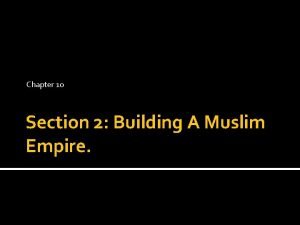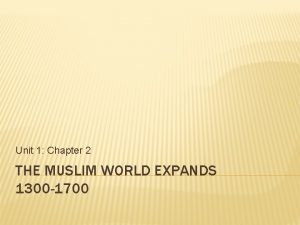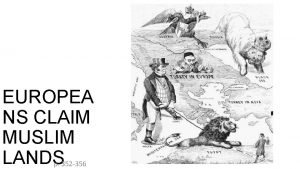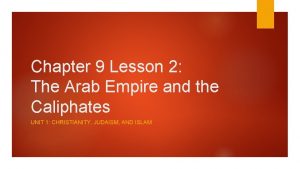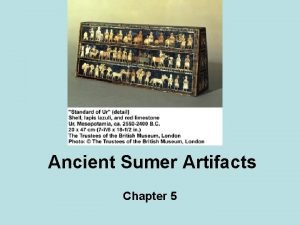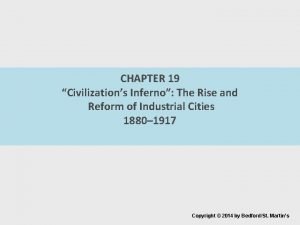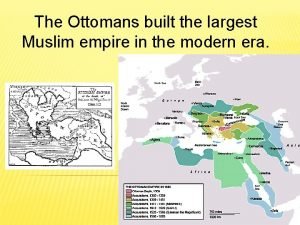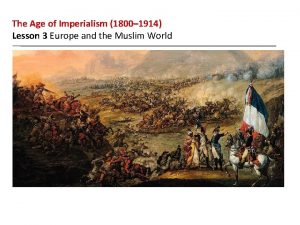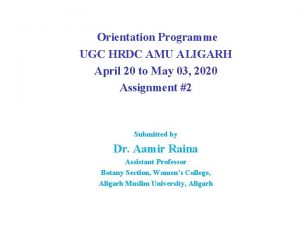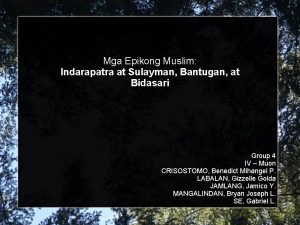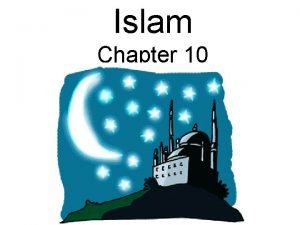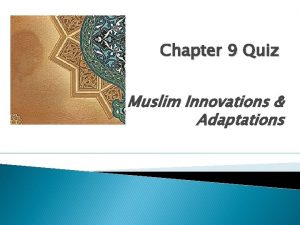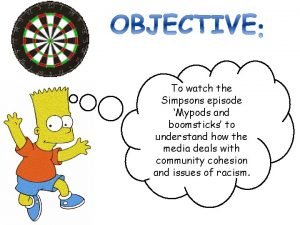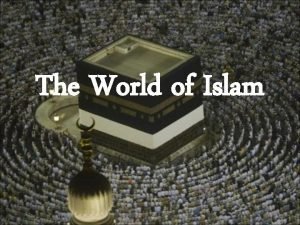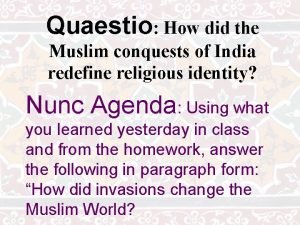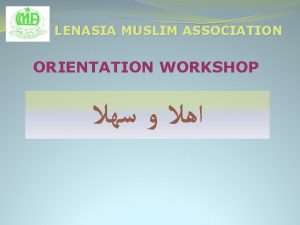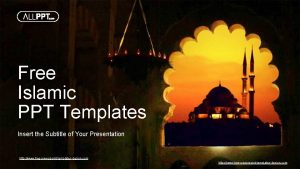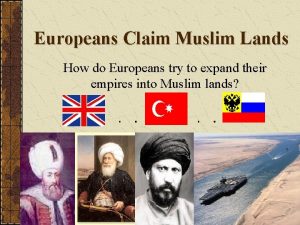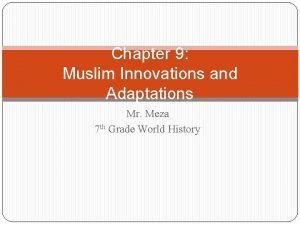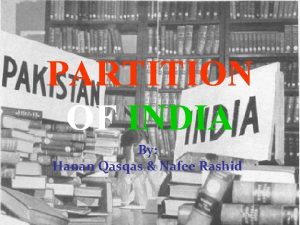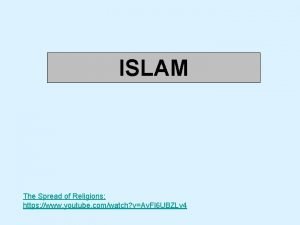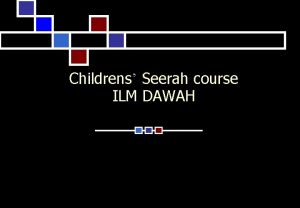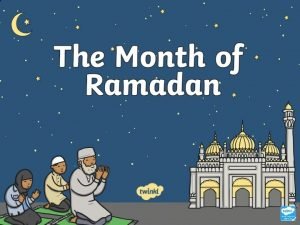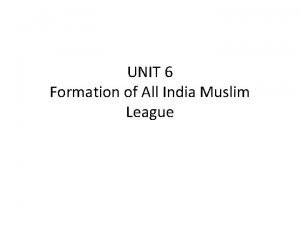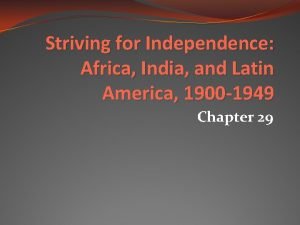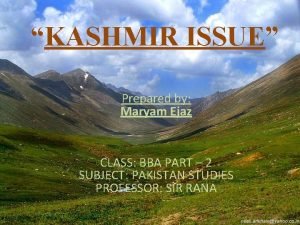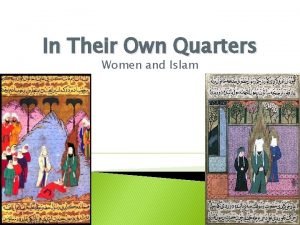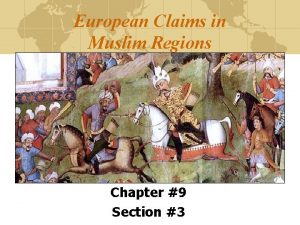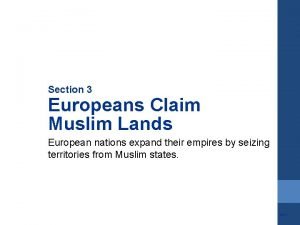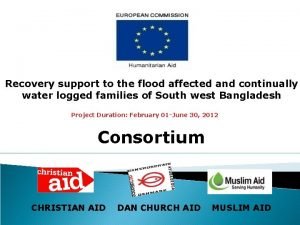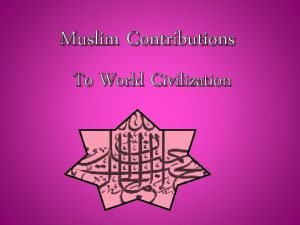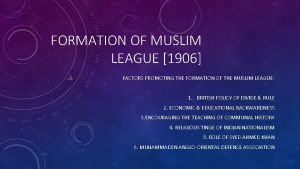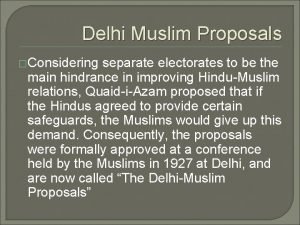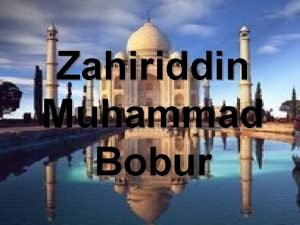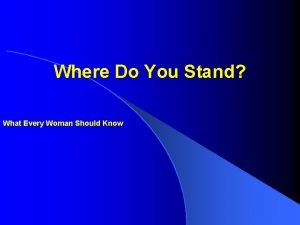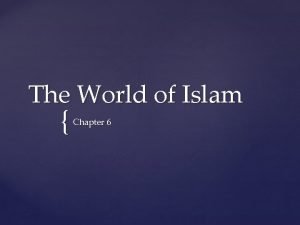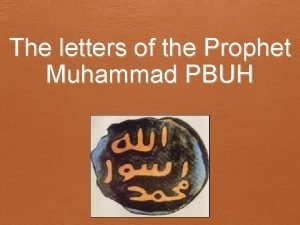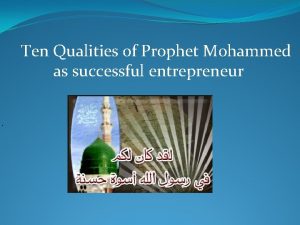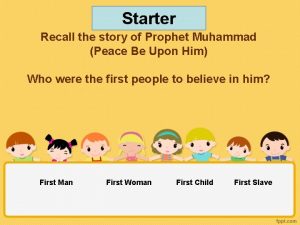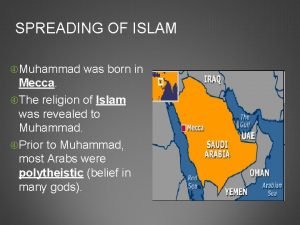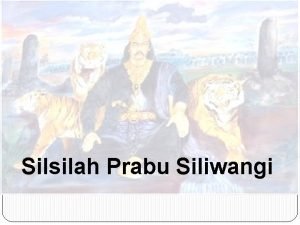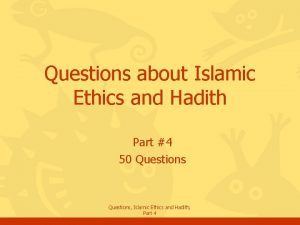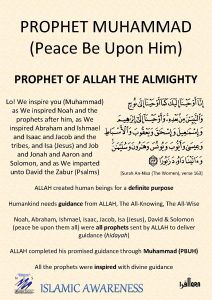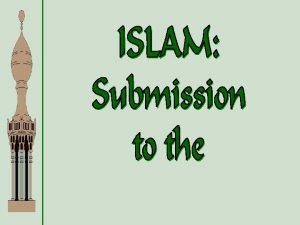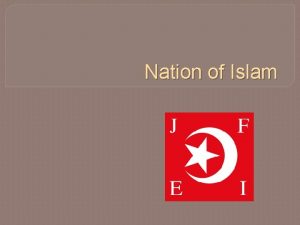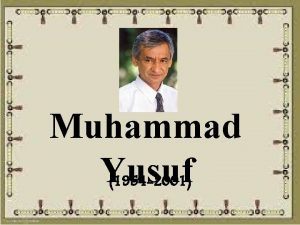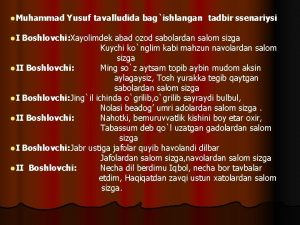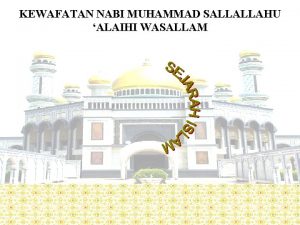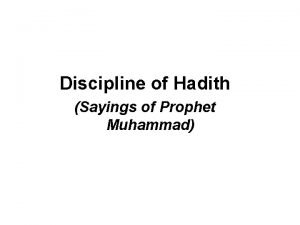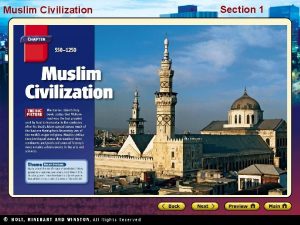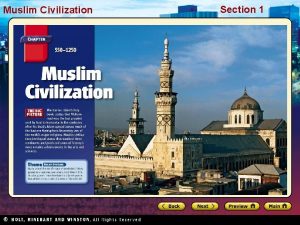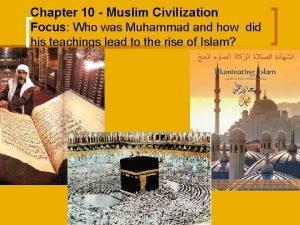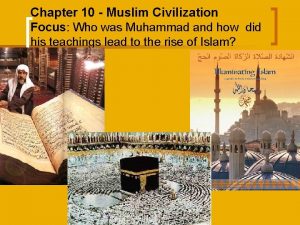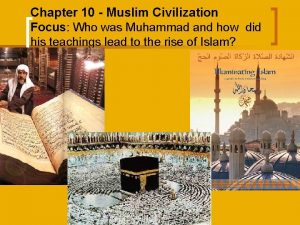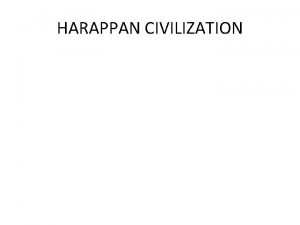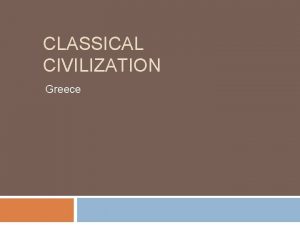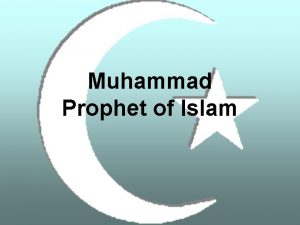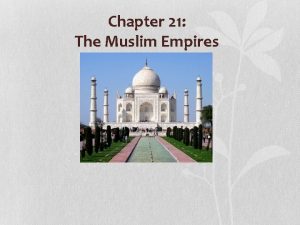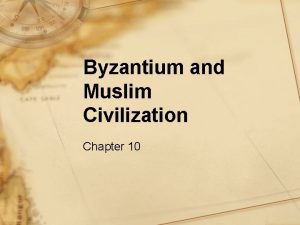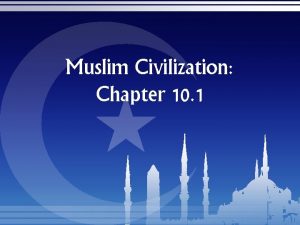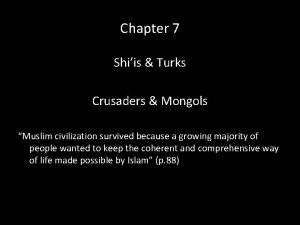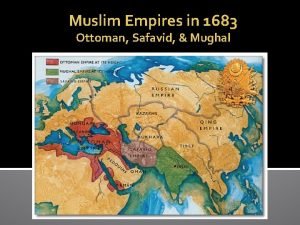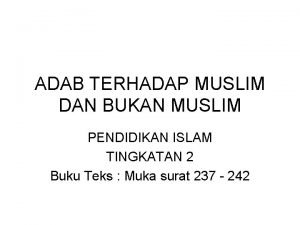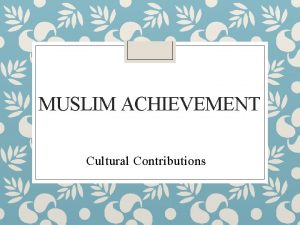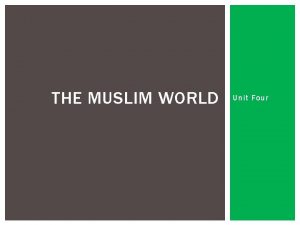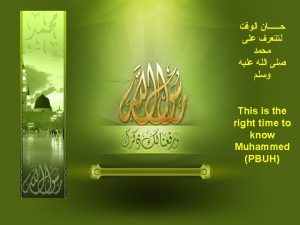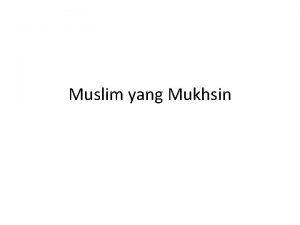Chapter 10 Muslim Civilization Focus Who was Muhammad









































































- Slides: 73

Chapter 10 - Muslim Civilization Focus: Who was Muhammad and how did his teachings lead to the rise of Islam?

Chapter 10 - Muslim Civilization n 10. 1 - The Rise of Islam n 10. 2 - Building a Muslim Empire n 10. 3 - Muslim Civilization Golden Age n 10. 4 - India’s Muslim Empires n 10. 5 - The Ottoman and Safavid Empires

10. 1 - Rise of Islam n Focus: What messages, or teachings, did Muhammad spread through Islam?

10. 1 - Rise of Islam n Followers of Islam are called Muslim* n Their holy text is the Quran* n Chief Prophet: Muhammad*

10. 1 - Rise of Islam n Islam begins: Muhammad was born in the oasis town of Mecca. ¡ Mecca: n Was a bustling market* n Pilgrimage center* n No weapons in the city* n Was home to many pagan gods* (statues)

10. 1 - Rise of Islam n Muhammad: (570 AD) ¡ led a modest life early on: ¡ He was an honest business man* ¡ Married at 25 (Khadija)* ¡ Devoted father and husband* ¡ Was troubled by the moral ills of society*

10. 1 - Rise of Islam According to Islamic belief, when Muhammad was 40 years old he heard the voice of an angel (Gabriel). Muhammad was uneasy, but became the messenger of god. *

10. 1 - Rise of Islam n Muhammad's Teachings: ¡ Weren’t widely accepted at first ¡ As they gained strength, angered Mecca’s merchants n Neglect of idols would disrupt trade

10. 1 - Rise of Islam n Muhammad’s Journey (Hijra): ¡ Muhammad left Mecca and entered the city of Medina. * n n Acceptance grows Thousands of Arabs adopt Islam ¡ With his followers he returned to Mecca to free the Kaaba, the temple he believed should be dedicated to one true God, of idols. * ¡ Rededicated the Kaaba to Allah (God), making it the most holy place of Islam. *

10. 1 - Rise of Islam n The Quran: ¡ ¡ ¡ Sacred text of Islam* States people are responsible for their actions Muslims believe that God (Allah) has sent other prophets: Jesus, Abraham, Moses… but Muhammad is the last and greatest of all.

10. 1 - Rise of Islam n Duties (expectations) of Islam: ¡ Islamic people follow The Five Pillars of Islam n Lay out the expectations of Muslims*

10. 1 - Rise of Islam n Pillar One: Shahada ¡ Declaration of faith* n “There is no god but Allah, Muhammad is the messenger of Allah. ”

10. 1 - Rise of Islam n Pillar Two: Salah ¡ Daily Prayer* n n Pray 5 times a day Wash Face Mecca Some pray in Mosques house of worship* ¡ But not required


10. 1 - Rise of Islam n Pillar Three: Zakat ¡ Alms for the Poor* n Give charity

10. 1 - Rise of Islam n Pillar Four: Ramadan ¡ Fasting* n n n Don’t eat from sun up to sun down Applies to other parts of life too, not just eating For the month of Ramadan (varies by year)

10. 1 - Rise of Islam n Pillar Five: ¡ Making a Pilgrimage (Hajj)* n n n Must make the journey at least once Pray at the Kaaba Over 2 million people a year





10. 1 - Rise of Islam n Jihad- struggle in God’s service* n To Muslims Islam is both a religion and a way of life n Their laws are based on the teaching of Islam- Sharia* n Islam and the Quran extended rights of women* - *however they must dress modestly - Varies by location

10. 2 Building a Muslim Empire n Focus: How did Muhammad’s successors extend Muslim rule and spread Islam?

10. 2 Building a Muslim Empire n Muhammed dies in 632 he named no successor: * ¡ Islam needed another strong leader n Abu Bakr - becomes the first: caliph – successor* n Reunites the Muslims n Leads military campaigns to unite other Arabs in Islam

10. 2 Building a Muslim Empire n n The Muslim Empire rapidly spread Conquering area including: ¡ Damascus ¡ Jerusalem ¡ The Persian Empire ¡ Byzantine Egypt

Create a Venn Diagram Sunni Muslims Shiite Muslims Common characteristics

10. 2 Building a Muslim Empire Death of Muhammad : created a split (schism) in the Empire: n Sunni versus Shiite Muslims n disagreed over who should be caliph (successor) n SUNNI- majority of Muslims; believed successors should be dedicated males* n SHIITE- believed the caliph must be a direct descendent of Muhammad*


10. 2 Building a Muslim Empire n n Sufis - Muslim Mystic* (a person who seeks wisdom and spiritual truth) Meditation, fasting, rituals Travel and preach like friars Whirling Dervishes- dance as a form of prayer

n 10. 2 Building a Muslim Empire n Muslim Empire grew from 661 - 750 Several Ruling Families (clans) ¡ Umayyad Dynasty- Sunni people n Ruled after the death of Ali (Muhamad’s son-in-law)

Umayyad Dynasty n n United the Muslim tribes Conquered land Allowed people to practice other faiths if they paid a special tax Declined after conflict between rich and poor and Shiite Muslims

Great Mosque of Cordoba, Spain

10. 2 Building a Muslim Empire Abbasid Dynasty n Abbasid – moved capital to Baghdad (750 -1258) Shiite Muslims n Reasons for success: ¡ Weakness of Byzantines and Persians ¡ Aggressive and bold fighting ¡ Strong unity under Islam

Muslim Empire- c. 750 SPAIN- Umayyad MED SEA BAGHDAD- Abbasids AFRICA ARABIA

10. 2 Building a Muslim Empire n As the Empire expanded: ¡ ¡ Conquered people were treated fairly Many conquered joined the Islamic faith n n n Non-Muslims taxed Equality The capital was moved to Baghdad (Damascus)* ¡ ¡ “Paradise on Earth” Beautiful city Market, Gardens, Domes Minarets- slender towers*

Baghdad

Baghdad’s House of Wisdom

10. 2 - The Muslim Empire Falls n Starting in 850 the Muslim Empire began to decline ¡ ¡ Independent dynasties – caliph loses power* Invasions*

10. 2 - The Muslim Empire Falls n n n Seljuk Turks migrated to the Middle East (900 s) Seljuk Turk Rulers (Sultan) - controlled Baghdad (1055) Conflicts prevent Christians from traveling to Jerusalem ¡ Cause the Crusades (1095) Christians v. Muslims

10. 2 - The Muslim Empire Falls n Mongols led by Genghis Khan move into Middle East (1216) n Eventually burn and loot Baghdad

10. 2 - The Muslim Empire Falls The culture still flourished in Spain n Until 1492 (Inquisition)

10. 3 - Muslim Golden Age Focus: What achievements did Muslims make in economics, art, literature, and science? n Muslim Golden Age ¡ ¡ n a time of prosperity 750 -850: 100 years During the Muslim Golden Age: n n Economy Advanced Social Structure Advanced Art, Literature, and Architecture Thrive Muslim Knowledge Expanded

Islamic Golden Age In your notebooks, divide a page into 4 sections and label the following: • Art, Literature and architecture pg 319 -320 • Learning, philosophy, history and science pg 320 -321 • Math and medicine pg 322 • Business practices pg 318 (3 rd paragraph from the top)

Muslim rulers unite many diverse cultures Arabs Persians Egyptians Africans Europeans

10. 3 - Economy Advanced n n Merchants were near the top of society (Muhammad was a merchant)* Built a massive trade route – camels, silk roads, ships* ¡ Asia ¡ Africa ¡ Europe

10. 3 - Economy Advanced n Muslim’s pioneered new business practices* n n Partnerships* Credit* Formed banks* Checks*

10. 3 - Social Structure Improves n n Social Mobility – changing of social class* Improve their position through achievements: n n n Religious Scholarly Military

Muslim Empire Included Greeks Romans Persians Indians

Art, Literature, & Architecture n n n Muslim art displayed many different cultures Religious - did not portray humans (Quran - no idols)* Poetry (oral) was used to tell stories

Muslim Architecture n n Mosque and Minarets decorated the skyline Calligraphy decorated buildings (beautiful handwriting)*

10. 4 India’s Muslim Empires Focus: How did Muslim rule affect Indian government and society?

10. 4 India’s Muslim Empires n Muslims move into Indian Empire around 1000 n By the late 1100’s the Sultan (Muslim Ruler)*: ¡ Defeated Hindu armies and claimed Delhi as his capital

10. 4 India’s Muslim Empires n Successors to the empire would rule what was known as the Delhi sultanate (lands of the sultan) ¡ Marked start of Muslim rule in India (1206 – 1526)

10. 4 India’s Muslim Empires n Muslim advances lead to a blending of cultures n Persian n Arab n Turks

10. 4 India’s Muslim Empires n Muslims and Hindus clash over: n Text : Quran vs. Many texts n God/ Gods: Allah vs. Many gods/goddesses n Equality vs. Caste: Many Hindus converted to Islam to due to: -*equality (before God) in Islam

n Text : Quran vs. Many

n God/ Gods: Allah vs. Many

Equality vs. Caste *Equality was appealing to Hindus

10. 4 India’s Muslim Empires n Eventually Delhi sultanate became tolerant of Hindus n n Even kept local Rajahs - Hindu rulers in place* Accepted Hindus as monotheistic (Brahman)

10. 4 India’s Muslim Empires n n n Mughal Empire Rises in India * 1526 -1857 Mughal = Persian for Mongol* ¡ Replace Delhi Sultanate


10. 4 India’s Muslim Empires n By 1707 The Mughal Empire had conquered most of the Indian Subcontinent n Led to the rise of Akbar the Great

10. 4 India’s Muslim Empires n 1556 Akbar the Great was the chief builder of the Mughal Empire* n n n Created a strong central government Tolerant of Hindus (married one) Promoted Religious harmony

10. 4 India’s Muslim Empires n The Taj Mahal built in 1643 n n Took 22, 000 workers & 20 years Greatest monument of Mughal Empire

10. 4 India’s Muslim Empires n Akbar’s Grandson Shah Jahan was also influential n While ruling the empire his wife Mumtaz Mahal would die: ¡ ¡ She gave birth to 14 children and was only 39 He loved her dearly so he built a monument (tomb) in her honor…the Taj Mahal

10. 5 – The Ottoman & Safavid Empires Focus: What were the main characteristics of the Ottoman and Safavid empires? n The Ottomans ¡ ¡ ¡ Migrated into Asia Minor (Turkey) Turkish-speaking nomads from Central Asia Took over Constantinople in 1453 (Istanbul) n n 1453 becomes Ottoman Capital Used new war tech ¡ the cannon

10. 5 - The Ottoman and Safavid Empires n Suleyman the Magnificent (1520 – 1566) See pg 330 n Great leader of the Ottoman Empire* n n n Extended Ottoman Empire into Middle East Known as the lawgiver ¡ Laws based on the Sharia, supplemented by royal edicts Held absolute power ¡ Used a vizier, huge bureaucracy, and powerful military

Ottoman Empire: Hungary to Arabia & Mesopotamia, and across North Africa

10. 5 - Ottoman and Safavid Empires Ottoman Culture n Organized social classes ¡ Top: “Men of the sword” (soldiers)* ¡ Middle: “Men of the pen” (scientists, lawyers, judges, & poets) ¡ “Men of negotiation” (merchants, artisans) ¡ Lowest: “Men of husbandry” (farmers & herders: produce food)* ¡ Janizaries – elite forces of the Ottoman army* n Usually born to Christian families but converted to Islam

10. 5 - Ottoman and Safavid Empires n Decline ¡ ¡ Suleiman the Magnificent dies in 1566 1700 s - European commerce and new war tech are superior Russia & other Europeans take over landholdings North Africa breaks away from Ottoman control


10. 5 – The Safavid Empire n n Ruled in most of Modern day Iran, Lots of Persian influence ¡ Between: n n n Ottomans - West Mughal India - East Shah (king) Abbas the Great ¡ Centralized gov’t ¡ Strengthened n the economy Safavid Empire decline ¡ ¡ Death of Shah Abbas Ottoman armies

10. 5 – Safavid Empire
 Allahumma salli ala muhammad wa ala ali muhammad in english
Allahumma salli ala muhammad wa ala ali muhammad in english Allahumma salli ala muhammad
Allahumma salli ala muhammad Prolepsis
Prolepsis Integrated cost leadership/differentiation strategy
Integrated cost leadership/differentiation strategy Differentiation cost leadership
Differentiation cost leadership Actor focus vs object focus
Actor focus vs object focus The muslim world expands chapter 18 answer key
The muslim world expands chapter 18 answer key Chapter 27 section 3 european claim muslim lands
Chapter 27 section 3 european claim muslim lands Chapter 27 section 3 european claim muslim lands
Chapter 27 section 3 european claim muslim lands Chapter 11 section 3 european claim muslim lands
Chapter 11 section 3 european claim muslim lands Chapter 10 the muslim world
Chapter 10 the muslim world Chapter 10 section 2 building a muslim empire
Chapter 10 section 2 building a muslim empire Where was the mughal empire located
Where was the mughal empire located Chapter 27 section 3 european claim muslim lands
Chapter 27 section 3 european claim muslim lands Chapter 8 lesson 1 greek culture
Chapter 8 lesson 1 greek culture Chapter 9 lesson 2 the arab empire and the caliphates
Chapter 9 lesson 2 the arab empire and the caliphates Was ancient sumer a civilization chapter 5
Was ancient sumer a civilization chapter 5 Chapter 19 civilization's inferno
Chapter 19 civilization's inferno Art in focus
Art in focus Biggest muslim empire
Biggest muslim empire For which reason did persia attract foreign
For which reason did persia attract foreign Sahih muslim 1050
Sahih muslim 1050 Hrdcamu
Hrdcamu Kapangyarihan ng bidasari
Kapangyarihan ng bidasari Bugtong halimbawa
Bugtong halimbawa Muslim social pyramid
Muslim social pyramid Muslim innovations and adaptations answers
Muslim innovations and adaptations answers Simpsons muslim episode
Simpsons muslim episode World of
World of Muslim aqiqah ceremony
Muslim aqiqah ceremony How muslim came to india
How muslim came to india Lenasia muslim association
Lenasia muslim association Muslim housing services
Muslim housing services Kauna unahang estado naitatag sa kanlurang africa
Kauna unahang estado naitatag sa kanlurang africa Islamic theme for powerpoint
Islamic theme for powerpoint Europeans claim muslim lands
Europeans claim muslim lands Muslim specialist hospital zaria
Muslim specialist hospital zaria Muslim innovations and adaptations
Muslim innovations and adaptations Muslim freedom fighters name
Muslim freedom fighters name What year was muhammad born
What year was muhammad born Muslim saladin retakes jerusalem
Muslim saladin retakes jerusalem Woman muslim
Woman muslim Things we should do in ramadan
Things we should do in ramadan All india muslim league 1906
All india muslim league 1906 All india muslim league 1906
All india muslim league 1906 Hukum syirkah
Hukum syirkah Conclusion of jammu and kashmir
Conclusion of jammu and kashmir Muslim women's quarters
Muslim women's quarters European claims in muslim regions
European claims in muslim regions Muslim art history
Muslim art history Europeans claim muslim lands
Europeans claim muslim lands Muslim aid
Muslim aid Muslim irrigation and underground wells
Muslim irrigation and underground wells Factors leading to the formation of muslim league
Factors leading to the formation of muslim league Delhi muslim proposals
Delhi muslim proposals Yoz fasli yor vasli
Yoz fasli yor vasli Gospel of barnabas muhammad
Gospel of barnabas muhammad Chapter 6 the world of islam answer key
Chapter 6 the world of islam answer key Prophet muhammad letters to kings
Prophet muhammad letters to kings Qualities of muhammad
Qualities of muhammad First child of prophet muhammad
First child of prophet muhammad Prior to muhammad’s teachings, arabs were polytheistic.
Prior to muhammad’s teachings, arabs were polytheistic. Anak keturunan prabu siliwangi
Anak keturunan prabu siliwangi Hadith on kinship
Hadith on kinship Islamic prophets family tree
Islamic prophets family tree How did prophet muhammad died
How did prophet muhammad died Was fard muhammad white
Was fard muhammad white Mehr qolur sheri
Mehr qolur sheri Muhammad nawaz sharif university of agriculture, multan
Muhammad nawaz sharif university of agriculture, multan Don e love makes the world go round
Don e love makes the world go round Muhammad yusuf tadbiri uchun senariy
Muhammad yusuf tadbiri uchun senariy Saat kewafatan nabi muhammad saw
Saat kewafatan nabi muhammad saw Muhammad amjad saqib
Muhammad amjad saqib Hazrat dawood family tree
Hazrat dawood family tree

